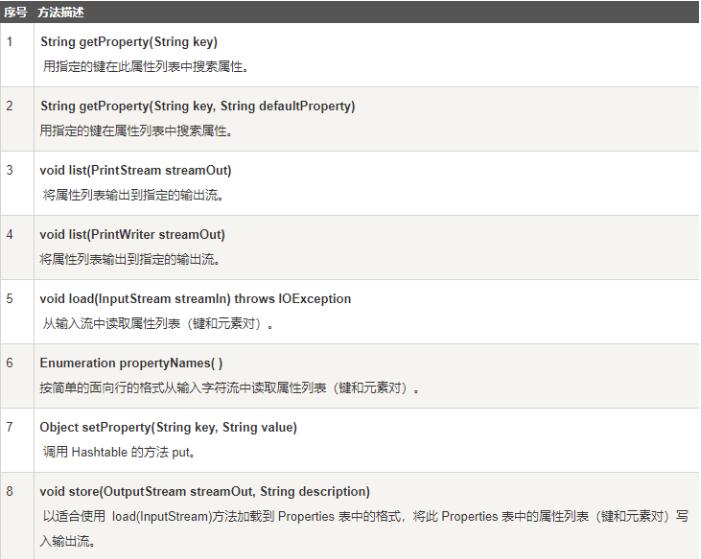一、properties文件
Properties文件是java中很常用的一种配置文件,文件后缀为“.properties”,属文本文件,文件的内容格式是“键=值”的格式,可以用“#”作为注释,java编程中用到的地方很多,运用配置文件,可以便于java深层次的解耦。
例如java应用通过JDBC连接数据库时,可以把数据库的配置写在配置文件 jdbc.properties:
|
1
2
3
4
|
driver=com.mysql.jdbc.Driver jdbcUrl=jdbc:mysql://localhost:3306/useruser=root password=123456 |
这样我们就可以通过加载properties配置文件来连接数据库,达到深层次的解耦目的,如果想要换成oracle或是DB2,我们只需要修改配置文件即可,不用修改任何代码就可以更换数据库。
二、Properties类
java中提供了配置文件的操作类Properties类(java.util.Properties):
读取properties文件的通用方法:根据键得到value
|
1
2
3
4
5
6
7
8
9
10
11
12
13
14
15
16
17
18
19
|
/** * 读取config.properties文件中的内容,放到Properties类中 * @param filePath 文件路径 * @param key 配置文件中的key * @return 返回key对应的value */ public static String readConfigFiles(String filePath,String key) { Properties prop = new Properties(); try{ InputStream inputStream = new FileInputStream(filePath); prop.load(inputStream); inputStream.close(); return prop.getProperty(key); }catch (Exception e) { e.printStackTrace(); System.out.println("未找到相关配置文件"); return null; } } |
把配置文件以键值对的形式存放到Map中:
|
1
2
3
4
5
6
7
8
9
10
11
12
13
14
15
16
17
18
19
20
21
22
23
24
25
26
|
/** * 把.properties文件中的键值对存放在Map中 * @param inputStream 配置文件(inputstream形式传入) * @return 返回Map */ public Map<String, String> convertPropertityFileToMap(InputStream inputStream) { try { Properties prop = new Properties(); Map<String, String> map = new HashMap<String, String>(); if (inputStream != null) { prop.load(inputStream); Enumeration keyNames = prop.propertyNames(); while (keyNames.hasMoreElements()) { String key = (String) keyNames.nextElement(); String value = prop.getProperty(key); map.put(key, value); } return map; } else { return null; } } catch (Exception e) { e.printStackTrace(); return null; } } |
Properties类使用详解
概述
Properties 继承于 Hashtable。表示一个持久的属性集,属性列表以key-value的形式存在,key和value都是字符串。
Properties 类被许多Java类使用。例如,在获取环境变量时它就作为System.getProperties()方法的返回值。
我们在很多需要避免硬编码的应用场景下需要使用properties文件来加载程序需要的配置信息,比如JDBC、MyBatis框架等。Properties类则是properties文件和程序的中间桥梁,不论是从properties文件读取信息还是写入信息到properties文件都要经由Properties类。
常见方法
除了从Hashtable中所定义的方法,Properties定义了以下方法:

Properties类
下面我们从写入、读取、遍历等角度来解析Properties类的常见用法:
写入
Properties类调用setProperty方法将键值对保存到内存中,此时可以通过getProperty方法读取,propertyNames方法进行遍历,但是并没有将键值对持久化到属性文件中,故需要调用store方法持久化键值对到属性文件中。
|
1
2
3
4
5
6
7
8
9
10
11
12
13
14
15
16
17
18
19
20
21
22
23
24
25
26
27
28
29
30
31
32
33
34
35
|
package cn.habitdiary;import java.io.FileInputStream;import java.io.FileOutputStream;import java.io.IOException;import java.io.InputStream;import java.io.OutputStream;import java.util.Date;import java.util.Enumeration;import java.util.Properties;import junit.framework.TestCase;public class PropertiesTester extends TestCase { public void writeProperties() { Properties properties = new Properties(); OutputStream output = null; try { output = new FileOutputStream("config.properties"); properties.setProperty("url", "jdbc:mysql://localhost:3306/"); properties.setProperty("username", "root"); properties.setProperty("password", "root"); properties.setProperty("database", "users");//保存键值对到内存 properties.store(output, "Steven1997 modify" + new Date().toString()); // 保存键值对到文件中 } catch (IOException io) { io.printStackTrace(); } finally { if (output != null) { try { output.close(); } catch (IOException e) { e.printStackTrace(); } } } }} |
读取
下面给出常见的六种读取properties文件的方式:
|
1
2
3
4
5
6
7
8
9
10
11
12
13
14
15
16
17
18
19
20
21
22
23
24
25
26
27
28
29
30
31
32
33
34
35
36
37
38
39
40
41
42
43
44
45
46
47
48
49
50
51
52
53
54
55
56
57
58
59
60
61
62
63
64
65
66
67
68
69
70
71
72
73
74
75
76
77
78
79
80
81
82
83
84
85
86
87
88
89
90
91
92
93
94
95
96
97
98
99
100
101
102
103
104
105
106
107
108
109
110
111
112
113
114
115
116
117
118
119
120
121
122
123
124
125
126
127
128
129
130
131
132
133
134
135
|
package cn.habitdiary;import java.io.BufferedInputStream;import java.io.File;import java.io.FileInputStream;import java.io.FileNotFoundException;import java.io.IOException;import java.io.InputStream;import java.util.Locale;import java.util.Properties;import java.util.PropertyResourceBundle;import java.util.ResourceBundle;/** * 读取properties文件的方式 * */public class LoadPropertiesFileUtil { private static String basePath = "src/main/java/cn/habitdiary/prop.properties"; private static String path = ""; /** * 一、 使用java.util.Properties类的load(InputStream in)方法加载properties文件 * * @return */ public static String getPath1() { try { InputStream in = new BufferedInputStream(new FileInputStream( new File(basePath))); Properties prop = new Properties(); prop.load(in); path = prop.getProperty("path"); } catch (FileNotFoundException e) { System.out.println("properties文件路径书写有误,请检查!"); e.printStackTrace(); } catch (IOException e) { e.printStackTrace(); } return path; } /** * 二、 使用java.util.ResourceBundle类的getBundle()方法 * 注意:这个getBundle()方法的参数只能写成包路径+properties文件名,否则将抛异常 * * @return */ public static String getPath2() { ResourceBundle rb = ResourceBundle .getBundle("cn/habitdiary/prop"); path = rb.getString("path"); return path; } /** * 三、 使用java.util.PropertyResourceBundle类的构造函数 * * @return */ public static String getPath3() { InputStream in; try { in = new BufferedInputStream(new FileInputStream(basePath)); ResourceBundle rb = new PropertyResourceBundle(in); path = rb.getString("path"); } catch (FileNotFoundException e) { // TODO Auto-generated catch block e.printStackTrace(); } catch (IOException e) { e.printStackTrace(); } return path; } /** * 四、 使用class变量的getResourceAsStream()方法 * 注意:getResourceAsStream()方法的参数按格式写到包路径+properties文件名+.后缀 * * @return */ public static String getPath4() { InputStream in = LoadPropertiesFileUtil.class .getResourceAsStream("cn/habitdiary/prop.properties"); Properties p = new Properties(); try { p.load(in); path = p.getProperty("path"); } catch (IOException e) { e.printStackTrace(); } return path; } /** * 五、 * 使用class.getClassLoader()所得到的java.lang.ClassLoader的 * getResourceAsStream()方法 * getResourceAsStream(name)方法的参数必须是包路径+文件名+.后缀 * 否则会报空指针异常 * @return */ public static String getPath5() { InputStream in = LoadPropertiesFileUtil.class.getClassLoader() .getResourceAsStream("cn/habitdiary/prop.properties"); Properties p = new Properties(); try { p.load(in); path = p.getProperty("path"); } catch (IOException e) { e.printStackTrace(); } return path; } /** * 六、 使用java.lang.ClassLoader类的getSystemResourceAsStream()静态方法 * getSystemResourceAsStream()方法的参数格式也是有固定要求的 * * @return */ public static String getPath6() { InputStream in = ClassLoader .getSystemResourceAsStream("cn/habitdiary/prop.properties"); Properties p = new Properties(); try { p.load(in); path = p.getProperty("path"); } catch (IOException e) { // TODO Auto-generated catch block e.printStackTrace(); } return path; } public static void main(String[] args) { System.out.println(LoadPropertiesFileUtil.getPath1()); System.out.println(LoadPropertiesFileUtil.getPath2()); System.out.println(LoadPropertiesFileUtil.getPath3()); System.out.println(LoadPropertiesFileUtil.getPath4()); System.out.println(LoadPropertiesFileUtil.getPath5()); System.out.println(LoadPropertiesFileUtil.getPath6()); }} |
其中第一、四、五、六种方式都是先获得文件的输入流,然后通过Properties类的load(InputStream inStream)方法加载到Properties对象中,最后通过Properties对象来操作文件内容。
第二、三中方式是通过ResourceBundle类来加载Properties文件,然后ResourceBundle对象来操做properties文件内容。
其中最重要的就是每种方式加载文件时,文件的路径需要按照方法的定义的格式来加载,否则会抛出各种异常,比如空指针异常。
遍历
下面给出四种遍历Properties中的所有键值对的方法:
|
1
2
3
4
5
6
7
8
9
10
11
12
13
14
15
16
17
18
19
20
21
22
23
24
25
26
27
|
/** * 输出properties的key和value */ public static void printProp(Properties properties) { System.out.println("---------(方式一)------------"); for (String key : properties.stringPropertyNames()) { System.out.println(key + "=" + properties.getProperty(key)); } System.out.println("---------(方式二)------------"); Set<Object> keys = properties.keySet();//返回属性key的集合 for (Object key : keys) { System.out.println(key.toString() + "=" + properties.get(key)); } System.out.println("---------(方式三)------------"); Set<Map.Entry<Object, Object>> entrySet = properties.entrySet(); //返回的属性键值对实体 for (Map.Entry<Object, Object> entry : entrySet) { System.out.println(entry.getKey() + "=" + entry.getValue()); } System.out.println("---------(方式四)------------"); Enumeration<?> e = properties.propertyNames(); while (e.hasMoreElements()) { String key = (String) e.nextElement(); String value = properties.getProperty(key); System.out.println(key + "=" + value); } } |
以上为个人经验,希望能给大家一个参考,也希望大家多多支持服务器之家。
原文链接:https://www.cnblogs.com/janson071/p/10082778.html















